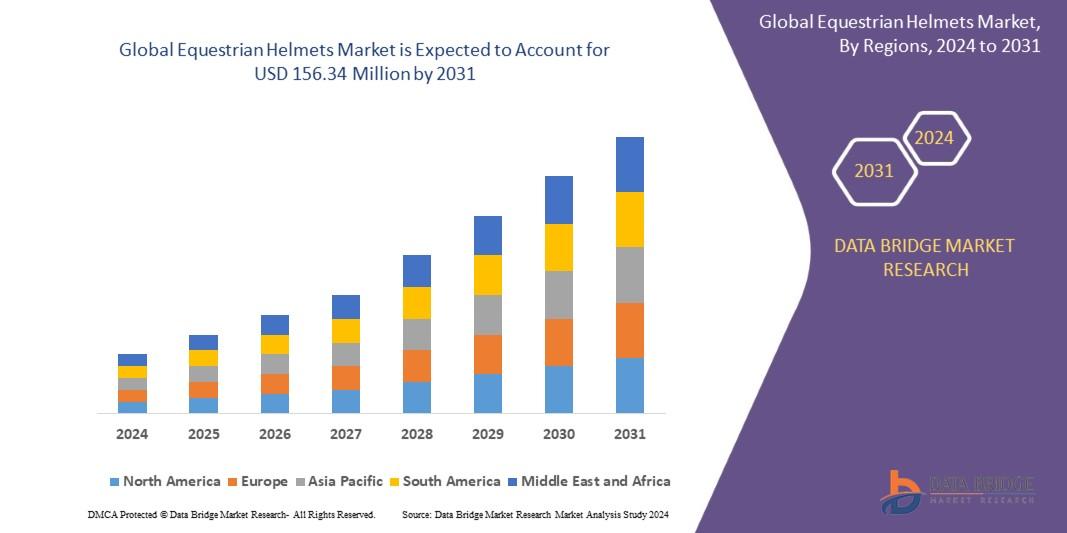
As the popularity of horse riding grows across both recreational and professional circles, safety equipment—especially helmets—has become essential. Whether in eventing, dressage, show jumping, or trail riding, equestrian helmets are a rider’s first line of defense against head injuries.
The Equestrian Helmets Market is expanding, driven by rising awareness of equestrian safety, increased participation in horse sports, and evolving helmet designs that merge functionality with fashion. With innovations like multi-directional impact protection systems (MIPS), lightweight composites, and breathable materials, manufacturers are redefining what it means to ride safely—and stylishly.
Get More Details: https://www.databridgemarketresearch.com/reports/global-equestrian-helmets-market
What Are Equestrian Helmets?
Equestrian helmets are specially designed protective gear worn by horse riders to prevent head injuries in case of falls, kicks, or other riding-related accidents. Unlike regular sports helmets, they are engineered to withstand impacts specific to horseback riding, offering enhanced skull and brain protection.
Key Helmet Types
- Traditional Riding Helmets: Used in general riding and English disciplines.
- Western Riding Helmets: Designed to blend with western-style outfits, often lightweight and well-ventilated.
- Show Helmets: Sleek, low-profile designs used in competitions and formal events.
- Schooling Helmets: Everyday-use helmets offering affordability and durability for training or practice.
Market Overview
The global equestrian helmets market was valued at approximately USD 720 million in 2023 and is projected to exceed USD 1.1 billion by 2030, growing at a CAGR of 6.5%. This growth is being fueled by the rising equestrian population in North America and Europe, safety mandates by equestrian federations, and a broader emphasis on sports injury prevention.
Key Market Drivers
🏇 Increased Participation in Equestrian Sports
- Competitive events like the Olympics, FEI World Equestrian Games, and national championships have popularized horse riding globally.
⚠️ Rising Safety Awareness
- Growing reports of traumatic brain injuries (TBIs) in horse riding have pushed demand for certified safety gear.
🛡 Regulatory Support
- Organizations like the US Equestrian Federation, British Equestrian Trade Association (BETA), and ASTM International enforce helmet use and quality standards.
👒 Fashion Meets Function
- Riders now seek helmets that provide protection without compromising on aesthetics, driving demand for customization, color choices, and designer options.
Material & Design Innovations
- MIPS Technology: Allows slight helmet movement to reduce rotational forces during impact.
- Carbon Fiber & ABS Plastics: Lightweight yet durable materials for performance-focused riders.
- Ventilation Systems: Mesh-lined vents to maintain airflow and reduce sweating.
- Adjustable Fit Systems: Internal dial mechanisms and padded liners ensure comfort and safety.
Regional Insights
- North America: Leads the global market with strong equestrian communities in the U.S. and Canada.
- Europe: Countries like the UK, Germany, and France show high adoption due to widespread competitive riding.
- Asia-Pacific: Growing middle-class interest in leisure sports is fueling equestrian clubs and safety gear purchases.
- Middle East: Increasing investments in horse breeding and racing, particularly in UAE and Saudi Arabia.
Challenges in the Market
⚠ High Cost of Premium Helmets
- Advanced safety features and materials increase retail prices, limiting adoption in price-sensitive markets.
⚠ Lack of Standardization in Emerging Regions
- Inconsistent safety regulations in some countries hinder consumer awareness and demand.
⚠ Counterfeit Products
- Low-quality imitation helmets pose serious risks and dilute brand trust.
Key Market Players
🏢 Charles Owen – British brand known for high-end safety and competition helmets.
🏢 Troxel Helmets – Offers affordable, stylish options for casual and trail riders.
🏢 GPA Safety Legend – Popular in professional circuits for its aerodynamic design.
🏢 Samshield – Combines luxury fashion with advanced technology.
🏢 Uvex Sports – German-engineered helmets with strong performance ratings.
Future Trends
🌱 Eco-Friendly Materials
- Rise in biodegradable shell materials and recyclable packaging.
🎯 Smart Helmets
- Integration of impact sensors, crash detection, and GPS tracking for rider safety and monitoring.
🛍 Online Customization Platforms
- Allow riders to design their own helmets, boosting e-commerce growth in the sector.
🎓 Awareness Campaigns
- Federation-led programs educating youth and amateur riders on helmet safety.
Conclusion
The Equestrian Helmets Market is evolving beyond basic safety. As the sport becomes more competitive and safety-conscious, helmets must offer cutting-edge protection, comfort, and visual appeal. With continued investment in technology, materials, and awareness, the industry is well-positioned to meet the demands of both new and seasoned riders.
FAQs
1. Are equestrian helmets different from bike helmets?
Yes. Equestrian helmets are specifically designed for horseback riding impacts, which differ from falls encountered in biking. They offer extended coverage at the back of the head and higher crush resistance.
2. What certifications should I look for in an equestrian helmet?
Look for helmets certified by ASTM/SEI (USA), VG1 (EU), or PAS015 (UK). These meet international safety standards.
3. How often should I replace my riding helmet?
It’s recommended to replace your helmet every 3–5 years, or immediately after a fall or visible impact.
4. Can helmets be used for all riding styles?
While some helmets are versatile, specialized helmets are recommended for disciplines like eventing or racing, which involve higher impact risks.
5. Are there equestrian helmets for kids?
Yes. Many brands offer youth-specific helmets with adjustable sizing and extra padding for comfort and growth.

